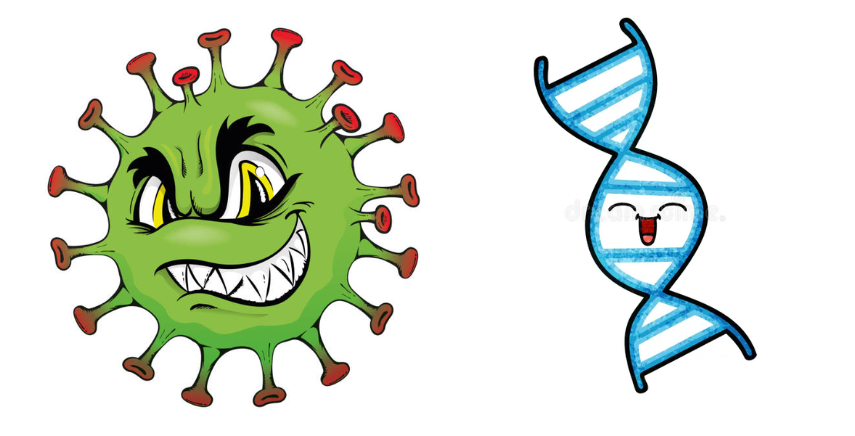Is Cancer Modern or Retro >_< ?
We have all known for quite some time now that Cancer is caused by mutations in the Human DNA which results in uncontrolled proliferation of the cell, resulting in tumors which sort of disrupt every function that the body is capable of. But believe you me, it was not always this simple. We still do not understand the exact mechanism behind this menace which is one of the reasons why it is so hard to come up with a cure. But today’s tale is not about the technicalities, rather it is about how once the research community was divided between viral and the genetic possibilities as potential causes for Cancer.

But why look at Viruses at all?
If Alexander Fleming and other scientists had never managed to reproduce penicillin in subsequent experiments and tests once it appeared accidently on the petri dishes, society might still be plagued by even the simplest of ailments. Simply put, in order to better understand something or make use of the discovery, it must be easily reproducible in the laboratory, and in the late 1960s this was not the case with Cancer. Although the obvious culprits had been rounded out by then - Tobacco, asbestos, X-Rays, but I think that even you would agree that it is not the most scientific or the best method to induce cancer in a cell/subject by exposing it to lethal doses of X-Rays, or making a person smoke 20 cigarattes a day. They needed a reiable way of inducing caner in cells which can then be studied further.
But there was one such candidate - Rous’s Sarcoma Virus was a rare virus that caused a rare cancer in a species of Chicken. And it’s namesake Peyton Rous, was already pushing Viruses as the key missing piece in the puzzle of Cancer’s causes. But little did he realise that this push would become the missing piece to a different puzzle than Cancer Viriology. But RSV came with it’s own caveats, the virus had never been isolated on a petri-dish to reliably study it. Until One day…
Cancer in a Petri-Dish:
Howard Temin joined Renato Dulbecco’s laboratory at Caltech in 1951 where he started his work in understanding the genetics of Fruit Flies, but soon shifted his focus to RSV with the aim of creating cancer in a petri-dish, and did indeed manage to do so. He was able to infect a few cells in a petri-dish with RSV and incite them to multiply and grow uncontrollably. This was groudnbreaking, if you did not realize it yet, this means that everything that is needed for the malignant process of cancer to begin and do it’s dirty work, all of it is present inside the cell itself.
Be my host
Having separated the devil from the host, Temin could now study cancer in ways that had not been thought possible, and boy was he in for a surprise… As any basic biology book would tell you, when a virus enters it’s host, it infects the cell, produce more viruses and then infect more cells. Nowhere in the process is the cell’s genetic makeup altered. But RSV behaved differently, the virus had physically ‘attached’ itself to the cell’s DNA structure, causing it to multiply uncontrollably, which was unprecendted.

The reason this was both surprising and confusing to Temin and his companions was that like many viruses RSV was also known to carry it’s genetic makeup in the form of RNA. Usually, it is this RNA that directly translates into viral proteins when a virus infects a cell and result in several copies of the virus from within the cell itself WITHOUT making any changes to the DNA makeup of the host cell. So how could a copy of the RSV’s genes convert to DNA, it was a well established fact in Cell Biology at that time that this was impossible.
But just as every groundbreaking discovery, this hypothesis from Temin would need some solid backing and he had none at the beginning. His was the job now to isolate the enzyme and obtain the evidence for this reverse flow of information from RNA to DNA. As interesting as the detailed story is, we wouldn’t dive into it here, but he and his colleagues did manage to isolate the enzyme responsible for this particular effect which was Temin’s evidence, evidence that RSV was no ordinary virus, it was infact a Retrovirus.
The Wall of Silence
Now the discovery made my Temin and a contemporary researcher was ground-breaking, and two reports containing very similar findings were published in Nature Magazine in 1970, and it was immediately hailed by Cancer Researchers as the default mechanism behind cancer. But this seemed to have no effect whatsoever on the cancer oncologists, and very little changed in how Cancer was treated and dealt with, even in the minds of people like Sidney Farber(the father of modern chemotherapy) who had attended the conference, this discovery offered little to no help in how Cancer could be treated.
The bubble
By this time, there were two prevalent theories on the cause of cancer - Exogenous and Endogenous. The Exogenous theory was basically the viral theory of cancer i.e. Cancer was caused by viruses, while the Endogenous theory looked inwards - at genes and the DNA as a possible causal agent for cancer. Temin’s discovery hinted that an RNA virus could enter a cell, make a DNA copy of it’s genes, and then attach that to the cell’s genome. This led one virologist - Sol Spiegelman to conjure an interesting theory.
Spiegelman suggested that over multiple generations these viral genes may get incorporated into a host’s genome and then get activated by a then unknown mechanism, and cause the cell to multiply uncontrollably. This theory was so tantalizing that Spiegelman set out to find retroviruses in almost all forms of cancer and more often than not, he ended up finding them. As more and more funding poured into this supposedly ground-breaking venture, Spiegelman managed to find more and more retroviruses which triggered even more funding, finally - people thought, a definite cause and hence a cure for the beast was within reach.
When labs all aroudn the U.S. tried to replicate Spiegelman’s findings, it was realized that in the frenzy of finding retroviruses and having already established them as a definite cause for cancer in his mind, Speigelman had found retroviruses in places they did not exist. All the money could not make Speigelman’s findings fly, but the discovery of retroviruses and the frenzied studies on them were definitely not for nought, as Spiegelman would take his last breathes, they would in the wake of a strange illness among gay men and people with blood transfusions, and an year after Spiegelman passed away, it would be a retrovirus that would rise up as the causal agent for the disease - the Human Immunodeficiency Virus or HIV, but that’s an article for next Sunday.
Enjoy Reading This Article?
Here are some more articles you might like to read next: